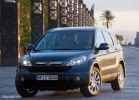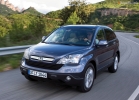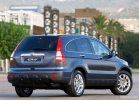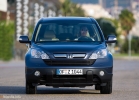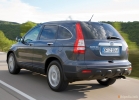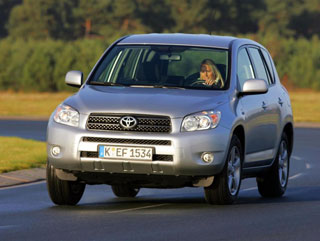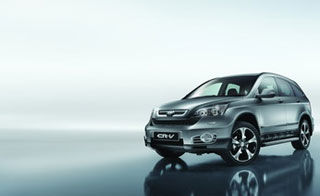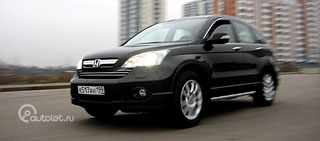Test drive Honda CR-V 2007-2009 SUV
Honda CR-V and Suzuki Escudo duel. Exam for the classic
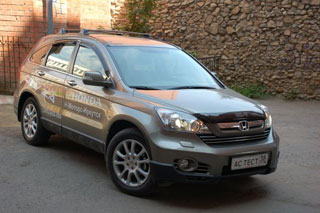 Suzuki Grand Vitara (Suzuki Escudo) against the backdrop of its parquet counterparts a unique car. He is an orthodox, and a kind of challenge of autoglobalization, and an indicator of fundamental engineering views, which in the light of the current technical depersonalization can be called conservative and promising at the same time. From 1988, by 2005, when the last generation appeared, Escudo got rid of only the solid rear axle, gaining a multi-link suspension, and a tight-sized integrated frame grown into the power structure of the body. While all manufacturers profess the transverse location of the unit, Suzuki is still a classic. While competitors are honed with all -wheel drive electronics, he is honest with him: Full Time with a forcibly blocked interdose differential and lowering nearby. Unprecedented by modern standards, insolence. Or maybe, according to the current concepts, even a chimera, forcing to recall the ancient controllability and comfort of bridge jeeps? Since Escudo has not yet been the hero of our tests, his dulyan Honda CR-V will help us to determine this.
Suzuki Grand Vitara (Suzuki Escudo) against the backdrop of its parquet counterparts a unique car. He is an orthodox, and a kind of challenge of autoglobalization, and an indicator of fundamental engineering views, which in the light of the current technical depersonalization can be called conservative and promising at the same time. From 1988, by 2005, when the last generation appeared, Escudo got rid of only the solid rear axle, gaining a multi-link suspension, and a tight-sized integrated frame grown into the power structure of the body. While all manufacturers profess the transverse location of the unit, Suzuki is still a classic. While competitors are honed with all -wheel drive electronics, he is honest with him: Full Time with a forcibly blocked interdose differential and lowering nearby. Unprecedented by modern standards, insolence. Or maybe, according to the current concepts, even a chimera, forcing to recall the ancient controllability and comfort of bridge jeeps? Since Escudo has not yet been the hero of our tests, his dulyan Honda CR-V will help us to determine this. Different faces of the parquet
How did the designers of the Suzuki company that did not create a single heavy SUV in their history manage to draw such a serious, brutal look? Sharp angles, sharply cut planes, rectangular without venture of optics, which would make the honor of Nissan Safari or Toyota Land Cruiser all this as if confirming the latitude of the all -wheel drive nature of Escudo. Against the backdrop of their associates on parquet crafts, trying on more and more magnificent and elaborate bio-forms, Suzuki a kind of peasant from nails, a charming guy from the hinterland, inspiring confidence. Even a body kit is not the embodiment of glamor, but an addition to the thoroughness of the image.
In Honda, nothing rudely-in-road. In the now fashionable Off-Road-light style, only the lower perimeter is a black unpainted plastic that covers the internal cavities of the wheel arches. Everything else is emphasized by the parquet world, which now, obviously, can give birth to such complex forms. Remember the simple first CR-V, the uncomplicated box of the second, and the last representative of the family seems to be something extraordinary. Only the rounding of the window opening from the back, not coinciding with the configuration of the body, looks slightly heavy and from that awkward. Gogdown metal in the likeness of glass, and it would have turned out a real all -resistant compartment. And so the first was X6.
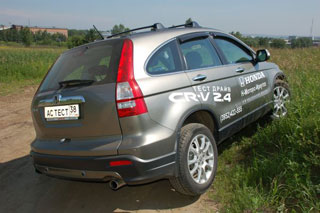 The continuation of the plastic Suzukovsky body kit with the steps and the cap was found in the cabin. There, the performance of Salomon offers a black and blue upholstery of seats and doors pleasant to the eye. As well as audio training in the absence of a branded head device, which implies an alternative in its choice. Alas, cooperation with a well -known manufacturer of Sportinentary did not affect the quality of interior plastics reinforced concrete hard and unpleasantly smooth. There are no complaints except to the joints. However, this does not deprive the Escudo salon of some eclecticism. Devices drowned in deep wells and easily readable scales with lunar lighting. Climate control of the rings, juicyly overwhelmed by positions, and the keys inside them, which meets harmonious clicks of pressing. And at the same time, over the central console of a simple graphics screen from Suzuki Swift with a clock, a sealing temperature and fuel consumption. And the work of designers who created the front panel can hardly be called inspired. But eclecticism is here. Still, a torpedo with simple and even banal forms will not be accused of the absence of clear ergonomic decisions. And you are placed in the driver’s seat in a lightweight seat, noting its non-pupilly rigidity, impressive amplitudes of adjustments and, unfortunately, only vertical movement of small in diameter of the steering wheel sheathed.
The continuation of the plastic Suzukovsky body kit with the steps and the cap was found in the cabin. There, the performance of Salomon offers a black and blue upholstery of seats and doors pleasant to the eye. As well as audio training in the absence of a branded head device, which implies an alternative in its choice. Alas, cooperation with a well -known manufacturer of Sportinentary did not affect the quality of interior plastics reinforced concrete hard and unpleasantly smooth. There are no complaints except to the joints. However, this does not deprive the Escudo salon of some eclecticism. Devices drowned in deep wells and easily readable scales with lunar lighting. Climate control of the rings, juicyly overwhelmed by positions, and the keys inside them, which meets harmonious clicks of pressing. And at the same time, over the central console of a simple graphics screen from Suzuki Swift with a clock, a sealing temperature and fuel consumption. And the work of designers who created the front panel can hardly be called inspired. But eclecticism is here. Still, a torpedo with simple and even banal forms will not be accused of the absence of clear ergonomic decisions. And you are placed in the driver’s seat in a lightweight seat, noting its non-pupilly rigidity, impressive amplitudes of adjustments and, unfortunately, only vertical movement of small in diameter of the steering wheel sheathed. Honda interior continuation of her appearance. In the driver flowing to the driver, as in minivans, in the parking brake horizontally and alarmist, in a multi-stage and multifunction steering wheel, it feels that the new policy of the company involves the conquest of customer hearts not so much by the groovy technology as design. It is a pity that rubber-plastic creativity was supplanted to the second roles to the attitude towards the materials themselves: everything is oak-hard and little in response to the image of CR-V as a stylish little thing.
At the same time, it is worth noting that the Honda service management is even more simple in understanding: a logical keyboard group, a simple indication on console displays. Only the verified geometry of the numbers in the combination of devices is disturbed by the mishmash of symbols on the screen between the scales. But the range of movements of the seat in CR-V is more impressive, and the horizontal adjustment of the steering column for granted.
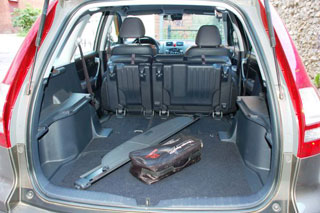 More spacious in Honda and behind, where passengers are a convenient sofa and natives in the doors. They do not have to count on more. At the same time, Escudo is ready to offer an ashtray, and a more comfortable sofa pillow for it, but less space in the knees.
More spacious in Honda and behind, where passengers are a convenient sofa and natives in the doors. They do not have to count on more. At the same time, Escudo is ready to offer an ashtray, and a more comfortable sofa pillow for it, but less space in the knees. The latter circumstance in no way affected the capacity of the trunk of the longitudinal motor-transmission layout compared to Honda, on average, cut off the Escudo compartment for 150 liters. Visually, this is confirmed even more, however, the advantage of Suzuki undoubtedly in one reserve on the door freed additional space under the floor. And the cars are united by a method of transforming the rear seat and not a single presence of sockets. By the way, regarding small containers between the SUVs, also Escudo equality was created at a time when a decent number of glutton-fuckers even became fundamental for Japan's domestic market. Are the asphalt settings fundamental, or do Suzuki still remember the whole -tank incorporation of the masses and a high center of gravity formed by the frame?
Not one parquet
The policy of our dealers, in general, is understandable to provide the potential consumer with the best, that is, the maximum configuration and the most powerful engine. And the fact that he will then choose a version of another, not so energy -warled and not so well equipped, is a kind of producer’s policy it seems to be not stipulated and can only be solved individually. This is that for the current comparative test we managed to take only CR-V with a 2.4-liter 166-horsepower engine. Nevertheless, earlier, until such a modification was exported, but+C tested a two -liter Honda. There is the possibility of comparison even within the framework of one model.
The difference in power and the moment is scanty, but it exists. Despite its small, frankly, for such a volume, a herd, the upper version of CR-V is a real field cannon, from which you can shoot straight aiming. Feasts are given with such ease that you begin to recall the former Honda ignorance with the notorious parques. At least earlier, this was not noticed for CR-V.
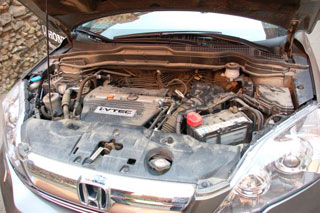 A two -liter Honda? Analogies are surprisingly quite appropriate. And there is no need to build on only 150 forces. Involuntarily, you recall that this brand of horses once had some others than competitors, since CR-V is light and extremely responsive to the rise. We will not say that in terms of return to Honda, some classmates are hardly close, one of course, in their ability to share power, it is equivalent to carriers with motors of a comparative volume and charge.
A two -liter Honda? Analogies are surprisingly quite appropriate. And there is no need to build on only 150 forces. Involuntarily, you recall that this brand of horses once had some others than competitors, since CR-V is light and extremely responsive to the rise. We will not say that in terms of return to Honda, some classmates are hardly close, one of course, in their ability to share power, it is equivalent to carriers with motors of a comparative volume and charge. The willing promotion almost to the red zone is adjacent to her with good traction at medium speeds. The incendiary four does not particularly like only the lower range. Not that it is badly pulling, but still with a small lazy one. Although it is not allowed to be distracted by a pleasant engine of the engine to be distracted by two or three thousand instantly, and there the unit is already inhaled in full chest.
A five -speed machine helps him to breathe correctly. Helps high quality. Soft, almost insinuating switching, perhaps, are not quite appropriate against the background of motor thirst for revolutions. But the Honda box in its efficiency is akin to modern multi -core computers. Or variators acts quickly and imperceptibly.
Competishing in this with Honda Escudo is quite difficult a four -speed automatic only in the Suzukovsky jeep, this year exchanged a third dozen (five -speeds exist only with V6). But not impossible! It is necessary to reconfigure the management program, which, apparently, was performed. Now switching in the box is smoother and without a last loss of long shares of seconds.
The Escudo power plant is generally a paradox and indicator. Firstly, because even its engine is already 12 years old. And secondly, due to the fact that he does not give out his elderly age. This four with a sharp disposition forces us to recall a two-liter V-image, which was installed on the first generation of Escudo. On the one hand, it is ridiculous to demand some superpowers from the engine. On the other hand, if desired, given the volume and power, it allows you to turn a difficult SUV into an acceptable passenger car. And the associations with Honda are easily acceptable here. The only difference is that the entire motor return is somewhat shifted down by turning down. In comparison with the K20A, the J20A is better picked up from idle and closer to the average, but the crankshaft rifting ends a little earlier. In general, the Suzukov old man proved that he has a good energy potential, which is so lacking in another much younger units, even an equipped phase change system.
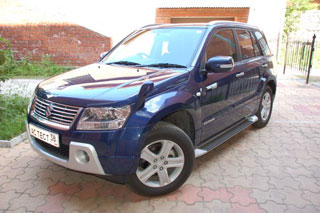 In order to completely dispose of the engine power, it is necessary to take into account some nuances of Escudo behavior. Of course, we are not talking about some classic juper settings. Even in comparison with previous generations, the new flagship Suzuki took a confident step towards the asphalt-di-dimensional ambitions. It is a pity that work in this direction is rather evolutionary than a revolutionary character. Are they holding the roots?
In order to completely dispose of the engine power, it is necessary to take into account some nuances of Escudo behavior. Of course, we are not talking about some classic juper settings. Even in comparison with previous generations, the new flagship Suzuki took a confident step towards the asphalt-di-dimensional ambitions. It is a pity that work in this direction is rather evolutionary than a revolutionary character. Are they holding the roots? Alas, they are not able to hold the body from the rolls. Suzuki will leave for them willingly and, although it does not scare them, but, of course, requires amendment on speed and corner of rotation. Within the framework of a small growth difference with CR-V, the reason, obviously, lies in the design of the frame, albeit integrated, increases the center of gravity.
Not entirely perfect in terms of controllability and the work of elastic elements. In a bend without road flaws, Escudo behavior (if you remember the rolls) causes delight. The car perfectly draws an arc, delighting with a rich effort on the steering wheel and its impeccable passency. But the joints and even more so the comb that are not perfectly worked out by amortizers springs, are ready to rearrange the car to a larger radius. By the way, the same thing is found on some classmates of Suzuki.
But not at Honda! Here it is a all -resistant compartment, where the first part of the definition (which is later) is clearly secondary. The steering is as transparent as that of Escudo. For other settings, CR-V traces a more obvious orientation on asphalt, on drive, and controllability. It is difficult to explain, say, smaller rolls. This is a set of works, procedures, the result of which was all denial of both the car and its driver, height, and dimensions. It is not surprising that Honda stabilization system
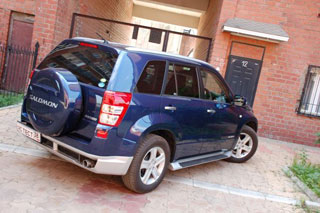 it is completely turned off, while Suzuki independently activates it when slipping or 40 km/h.
it is completely turned off, while Suzuki independently activates it when slipping or 40 km/h. And against the background of this, quite acceptable smoothness. It is only necessary to make a reservation that the 2.4-liter modification reacts tightly to all the bumps, nervously perceiving patches and not allowing to quickly run up on a rocky primer. The two-liter CR-V in handling their passengers is noticeably more cultured. Naturally, it is impossible to talk about the notorious business companies, the seams and police are felt. But, for example, according to gravel, this Honda queries with indicative indifference.
Escudo orientation smooth asphalt. It is strange to observe this precisely from the SUV. Nevertheless, the car does not like the fact of transverse road cutting, bringing to the attention of many nuances of former road well -being sitting inside. The situation is no better on gravel. It would seem that the concept of Suzuki should assume a comfortable and speedy movement on rather poor coatings. On Escudo it is better to steal than fly. You go faster, and a rigid hollow from stones begins to go into the salon, the fluctuations of unsproved masses become sensitive. We will paint to the Buyakov.
Unfortunately, sunny weather did not provide opportunities in the implementation of all -wheel drive. In our case, this, perhaps, is not entirely necessary. CR-V still has Part Time 4wd, based on two pumps. In a proprietary interpretation, it is called Real Time a real all -wheel drive. In fact, it is only that the rear pair of the wheels when the front slip is now connected faster. Forced blocking of the Dual Pump coupling, as before, is absent.
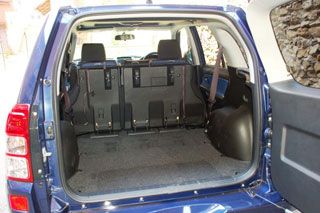 The all -wheel drive Escudo system was said at the beginning of the article. Well, when using the same tires, his Wead, presumably, will result in the ability to move where CR-V will stand for a long time. Or sit. By the way, a speedy landing for Honda is also guaranteed by passenger passages of wheels. It was possible that CR-V surrendered, on which CR-V, was not excluded, CIVIC would also enter. And in this case, Suzuki held the roots, clinging to the ground with all four.
The all -wheel drive Escudo system was said at the beginning of the article. Well, when using the same tires, his Wead, presumably, will result in the ability to move where CR-V will stand for a long time. Or sit. By the way, a speedy landing for Honda is also guaranteed by passenger passages of wheels. It was possible that CR-V surrendered, on which CR-V, was not excluded, CIVIC would also enter. And in this case, Suzuki held the roots, clinging to the ground with all four. In fact, it is thanks to its preserved off -road genetics that Escudo seems to be a more universal tool. In the city, it is not much worse (and in some cases this expression itself can be called) competitors. Outside of hard coatings is definitely better. If you do not focus on the unimportant smoothness of the course, not to see simple materials and interior design, then Suzuki is able to largely respond to the concept of an all -resistant vehicle.
When moving to CR-V with asphalt, you must have brakes in the brakes. Returning back, you can turn on the anti -lock system and turn off the VSA so good with it is so good. We repeat once again, in those conditions when Off-Road is limited to short without strong fractures of the relief with a primer to the garage or cottage.
SPECIFICATIONS
Honda CR-V Suzuki Escudo car
Length/width/height, mm 4 530/1 820/1 680 4 390/1 810/1 695
Wheel base, mm 2 620 2 640
The track in front/back, mm 1 565/1 565 1 540/1 560
Road clearance, mm 157 200
Equipped mass, kg 1 533 1 550
Fuel tank volume, l 58 66
Working engine volume, cubic meter. see 1 997 1 995
Power, l. with. at rpm 150/6 200 145/6 000
Torque, NM at rpm 192/4 200 193/4,000
Automatic gearbox, 5-speed automatic, 4-speed
The drive is full, with an automatically connected rear pair of wheels, a constant full, with a forcedly blocked by an interdose differential and lowering a nearby
Front suspension McPherson McPherson
Rear suspension multi -link multi -link
Front/rear circular ventilated/disk ventilated circular ventilated/disk
Tires 225/65 R17 225/65 R17
Maximum speed, km/h 177 180
Acceleration time to 100 km/h, from 12.2 n. D.
Fuel consumption, l/100 km
City cycle 10.9 12.5
Country cycle 6.7 7.7
Mixed cycle 8.2 9.5
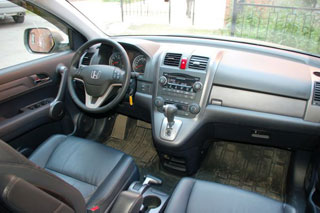
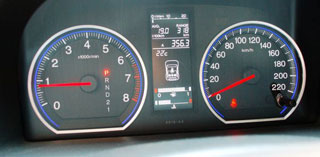
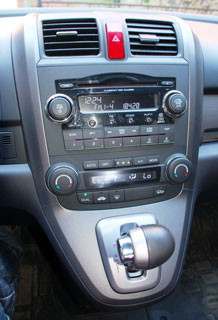
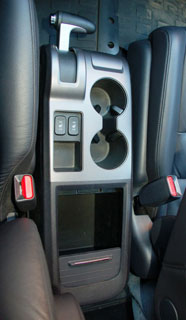
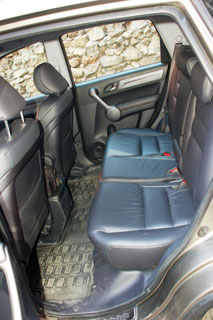
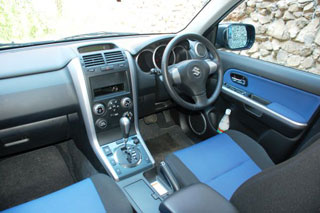
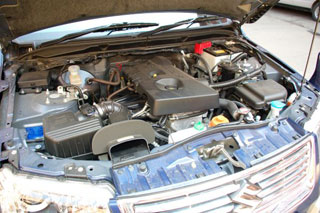
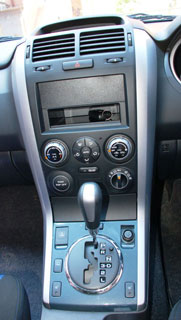
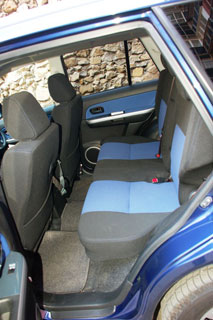
A source: Automarket+sport
Honda CR-V 2007-2009 Crash Video tests
Honda CR-V 2007 test drives-2009
Honda CR-V 2007 Krash Test-2009
Krassh Test: Detailed Information33%
Driver and passengers
13%
Pedestrians
37%
Children-passengers

